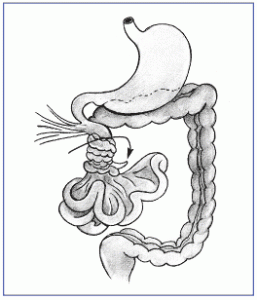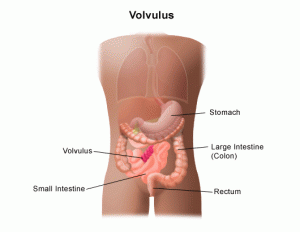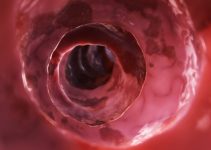Volvulus Definition
Page Contents
- 1 Volvulus Definition
- 2 Volvulus Types
- 3 Volvulus Causes
- 4 Volvulus Symptoms
- 5 Volvulus Associated Conditions
- 6 Volvulus Prevention
- 7 Volvulus Diagnosis
- 8 Volvulus Differential Diagnosis
- 9 Volvulus Treatment and Management
- 10 Volvulus Complications
- 11 Volvulus Diet
- 12 Volvulus Prognosis
- 13 Volvulus Incidence
- 14 Volvulus Pictures
It refers to a condition in which a loop of the bowel gets twisted abnormally, causing intestine damage and blood flow obstruction in the affected area. It occurs due to a birth defect known as intestinal malrotation which generally occurs during the tenth week of gestation. However, Volvulus can also affect individuals who do not have an intestinal malrotation. It usually develops within the first year of life.
Volvulus Types
This disorder is divided into several types according to the location of the abnormality:
Volvulus Neonatorum
This type specifically refers to the condition when it is present in neonates.
Gastric Volvulus
The twisted loop of bowel is present in the stomach of the patient.
Intestinal Volvulus
The abnormality is present in the small intestine.
Cecal Volvulus
It affects the entrance of the colon or large intestine.
Transverse Volvulus
A loop of bowel across the middle part of the colon causes this form of the condition.
Sigmoid Volvulus
The abnormality is present somewhere at the end section of the colon.
Splenic Flexure Volvulus
A twisted bowel loop in the left colic or splenic flexure leads to the disorder.
Compound Volvulus or Ileosigmoid Knot
It occurs when the ileum enwraps the base of sigmoid, passes beneath itself to form a knot.
Volvulus Causes
The principal cause of the disorder is intestinal malrotation which is generally present at birth. It is important to know how this malrotation occurs in order to understand the cause of Volvulus. Different organ systems start developing and maturing when the fetus grows in utero.
At the initial stage of its growth, the digestive tract is a straight tube extending from the stomach of the fetus to the rectum. At first, it is situated in the abdomen. However, a specific portion of the intestine enters the umbilical cord for a while. During the tenth week of pregnancy, the intestine returns to the abdomen of the fetus, leaving the umbilical cord. It makes two turns once it is back in the abdomen, which means the intestine no longer remains a straight tube. Sometimes, it fails to make these turns properly. This leads to intestinal malrotation.
Volvulus develops during the first months after birth due to these intestinal abnormalities. The twisted intestine causes intestinal blockage and obstructs the intestinal blood flow, ultimately leading to severe damage of the intestine.
Know about the causes for different forms of the condition:
Gastric Volvulus
Various stomach problems such as hiatus hernia, diaphragm defects, stomach tumors and weak muscles can result in the disorder.
Intestinal Volvulus
In some cases, a web-like material gets stuck to the intestine walls following a surgery and results in twisting of bowel. It is also associated with other conditions including diabetes, chronic constipation and Parkinson’s disease.
Cecal, Sigmoid and Transverse Volvulus
These types of the condition can result from various stomach disorders, such as constipation, that cause the large intestine to overstretch. The overstretched intestine can easily get twisted around itself and lead to the disorder.
Volvulus Symptoms
The symptoms of this disease are caused by two principal mechanisms:
- Bowel obstruction
- Reduction in blood flow (Ischemia)
The symptoms generally vary depending on what form of Volvulus a patient is suffering from. The common symptoms include:
- Abdominal distension
- Vomiting
- Nausea
- Lack of flatus or stool
- Abdominal pain
- Abdominal swelling
- Constipation
- Abdominal pain and tenderness
- Rapid heart rate and breathing
- Shock
- Bloody bowel movements
- Vomiting greenish yellow material
It can even lead to the death of a patient by destroying all the functional intestines.
Volvulus Associated Conditions
According to studies, around 70% of children born with this intestinal abnormality also have some other birth defects including:
- Digestive system abnormalities and abdominal wall defects like Congenital Diaphragmatic Hernia, Omphalocele, Gastroschisis, Hirschsprung’s Disease and anorectal malformations
- Heart defects
- Liver or spleen abnormality
Volvulus Prevention
It is not possible to prevent the condition when it is caused by intestinal malrotation in the fetus. This is due to the fact that there is no way to prevent this abnormal turning of the intestine. Intestinal malrotation is a congenital defect and no tests or exams are available that can help the mother or the doctors to find out whether the intestine of the fetus is likely to make improper turns. However, it might be possible to keep the disorder from occurring in adults by taking a few measures for preventing chronic constipation. Following a high-fiber diet may also lead to excessive stretching of one’s colon. Naturally, it is important to monitor the intake of high-fiber food. One should also increase the intake of potassium. Low potassium levels in the body for long periods of time may increase the risk of the intestinal abnormality. It is also important to control excessive laxative use as it can contribute to the development of Volvulus.
Volvulus Diagnosis
This condition is not evident until the intestine is substantially obstructed or twisted by Ladd’s bands, leading to the symptoms. The doctor initially analyzes the symptoms present in the patient and recommends various diagnostic tests if he or she suspects the patient to have an abnormal twist in the intestine. There are various imaging studies and blood tests that help in the evaluation of the intestine’s position and detect any twisting or blockage in it. The common tests used for the purpose include:
Abdominal X-ray
It can assist in revealing any intestinal obstruction.
Barium Swallow Upper Gastrointestinal Test
In this procedure, the small intestine is examined for any abnormalities. It also establishes the relative position of the patient’s jejunum, spine and stomach. At the beginning of the test, a nasogastric tube is used for placing some barium fluid inside the stomach of the patient. This fluid helps to produce x-ray images of the stomach and intestine by forming a thin coat around them. The x-ray can show if the patient has any duodenal obstruction, malrotation or other similar problems.
Barium enema
This test uses the similar principals as the barium swallow upper gastrointestinal test; however, it is used for examining the large intestine. Barium is inserted into the rectum in the form of enema. The test helps to detect any irregularity in the positioning of the large intestine.
Abdominal Ultrasound
In this diagnostic test, invisible electromagnetic energy beams are used for producing ultrasound images of the internal organs. Abdominal ultrasound is very helpful for studying the functioning of the internal organs and assessing the blood flow through different vessels.
Radiography
Upright, lateral and supine radiographs can help in the detection of bowel obstruction and intestinal malrotation. It is mainly useful for diagnosing large bowel obstructions as plain radiographs often show normal results for people with simple malrotation.
Volvulus Differential Diagnosis
The following conditions need to be considered during diagnosis:
- Appendicitis
- Annular pancreas
- Bowel obstruction
- Presence of foreign objects in bowel
- Colic
- Cholecystitis
- Duodenal Atresia
- Postoperative adhesions (scar tissue)
- Gastroenteritis
- Constipation
- Hepatitis B
- Gastro-esophageal reflux
- Hirschsprung’s disease
- Duodenal web
- Henoch-Schönlein Purpura
- Meckel’s Diverticulum
- Intussusception
- Incarcerated Hernia
- Ovarian torsion
- Sickle Cell Crisis
- Hypertrophic Pyloric Stenosis
- Peptic ulcer
- Necrotizing Enterocolitis
- Perforated Viscus
- Pancreatitis
- Urinary tract infection
- Renal stones
Doctors must ensure that patients are not suffering from any of the aforementioned disorders and the symptoms are actually indicative of Volvulus.
Volvulus Treatment and Management
The treatment options for the condition may vary depending upon its severity and the location of obstruction. Surgery may be necessary for repairing severely damaged intestines. Various non-surgical treatment options are available for correcting less severe cases of the disease. The non-surgical procedures are more suitable for older patients. The following factors are considered for determining the most useful treatment option for children:
- The age, medical history and overall health of the child
- The magnitude of the condition
- Expectations regarding its course
Non-Surgical Treatment
Performing a Sigmoidoscopy is recommended if the disorder is present in the sigmoid. A rectal tube may be placed for intestinal decompression in cases where the sigmoid mucosa appears normal and pink on the Sigmoidoscopy. It is helpful for curing the symptoms of vomiting and abdominal discomfort resulting from the bowel obstruction. The treatment also includes resolving any electrolyte, fluid, cardiac, renal and pulmonary irregularity.
The respiratory system may need to be supported with ventilation and intubation. Prophylactic broad-spectrum antibiotic medicines are administered in cases where the decreased bowel vascular blood supply is causing necrosis.
The treatment for Volvulus in children generally begins with intravenous (IV) fluids for preventing dehydration. Antibiotics are also prescribed for preventing infection.
A patient may experience excessive fluid loss in the sigmoid colon due to vomiting, which may result in shock. In such cases, it is recommended to treat the shock with fluid replacement therapy before addressing the main condition.
Surgical Treatment
Many cases of Volvulus require surgical intervention. The type of surgery to be used for the treatment is decided by a doctor depending upon various factors like the amount of reduction in the blood flow (Ischemia) and the necrotic (dead) bowel tissues.
Ladd’s procedure is the most common surgery used for the purpose of untwisting the bowel. In this procedure, the small intestine is rotated anti-clockwise for correcting the abnormality. The cecum is place in a proper location in left abdomen while the duodenum is directed through the right para-vertebral gutter. Sometimes, another laparotomy is used for around 36 hours after the surgery for ensuring the functionality of the remaining intestine.
In case of the neonatal form of the disorder, the surgery for correcting the abnormality is performed as early as possible after a baby is born. Ideally, there is restoration of blood circulation within the intestine once it is untwisted. This allows it to regain the normal pink coloration. The healthy intestine is then replaced in the abdomen of the patient. Usually, an appendectomy is also performed during this time. This is because the surgery of the intestine results in an alteration in the location of the appendix. This may cause trouble in diagnosing appendicitis in future.
A major section of the intestine needs to be removed if the condition is found to affect a wide area. In such circumstances, it is not possible to surgically attach the remaining intestine to each other after removing the damaged part. The surgeon may perform an ostomy to help the digestive process of the patient to continue working. The two healthy ends of the intestine are passed through the abdominal openings with an ostomy. The stool is allowed to pass through this opening and reach a collection pouch. The stoma can be permanent or temporary, depending on the quantity of intestine removed.
Volvulus Complications
Death and gangrene of the tissues in the affected area is the most common and dangerous complication of this condition, unless treated properly at an early stage.
- Complications of a persisting Midgut Volvulus include ischemia, mucosal sepsis, necrosis and even death of the patient.
- Chronic Intermittent Volvulus can cause malabsorption and constipation along with diarrhea.
- Post-surgery complications of the condition may include various problems regarding the parenteral nutrition such as growth retardation, hepatobiliary dysfunction and line sepsis.
Volvulus Diet
Patients generally have to follow some specific dietary restrictions before as well as after treatment. The diet to be followed after treatment of the disease is determined by the level of bowel distress. In severe cases, the bowel may take longer to recover completely after surgery. This means that the patient cannot be fed orally for a longer period of time. Parenteral feeding is used for these patients. Short-Bowel Syndrome is likely to develop if a considerable amount of bowel had to be removed. Patients may have to follow certain dietary modifications for the rest of their lives and may also need long-term hyperalimentation supplementation.
However, normal feeding can be resumed with the recovery of the bowel if no complicating factors are present. It is not necessary to follow any special diet for these individuals.
Volvulus Prognosis
The prognosis of the disease varies from one patient to another depending on various factors. The outcome is generally positive when the affected portion of bowel is removed before it causes any serious intestinal damage. However, removing a large part of the intestine due to damage may cause significant harm to the patient’s digestive process. The risk of recurrence of the disease is higher in patients treated by non-surgical procedures compared to those treated by surgery.
Volvulus Incidence
Intestinal malrotation is present in one out of every five-hundred live births in United States. Boys and girls are equally affected by it. However, boys are more likely to develop the symptoms during the initial month of their lives.
The condition can occur in individuals from any age group. However, statistics show it to be more prevalent among infants aged below one year and middle-aged men.
The mortality rate associated with untreated cases or non-surgically treated severe cases of the disorder is around 80%.
Volvulus is a serious condition that can be present at birth or may develop later in the life of an individual. Early diagnosis, along with proper and timely treatment, is very important for a patient to live a long and normal life.
Volvulus Pictures
Here are some pictures displaying the abnormal twist in the bowel which gives rise to this disease.
Picture 1 – Volvulus
Picture 2 – Volvulus Image
References:
http://www.cincinnatichildrens.org/health/i/intestinal-malrotation/
http://www.patient.co.uk/doctor/Volvulus-and-Midgut-Malrotations.htm
http://health.nytimes.com/health/guides/disease/volvulus-childhood/overview.html
http://www.lpch.org/DiseaseHealthInfo/HealthLibrary/digest/malrotat.html
http://emedicine.medscape.com/article/930576-overview



